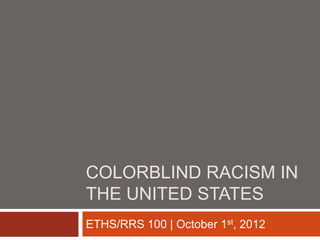
Racial Disparities Persist Despite Civil Rights Gains
- 1. COLORBLIND RACISM IN THE UNITED STATES ETHS/RRS 100 | October 1st, 2012
- 2. Historical Shifts Pre 1960 the United States had both De Jure and De Facto Racism The Role of the Civil Rights Movement Challenging Covert Racism Tactics: Pleas for Racial Equality Elimination of Difference; Race seen as Racism Integration Racism as ‘Mean’/ Immoral
- 4. Yet, Racial Disparities Continue... Civil Rights eliminated De Jure Racism Did not rectify unequal advantages and disadvantages “Racism Lite”
- 5. Disparities Income Education Health Incarceration
- 6. Income Median Family Income (2010): White: $62,545 Black/ African American: $38,409 Asian/ Pacific Islander: $75,027* Hispanic/Latino: $30,653 Percent Below Poverty Level (2009) White Alone: 12.3% Black Alone: 25.8% Asian Alone: 12.5% Hispanic: 25.3% United States Census Bureau (2010). “Money Income of Families, Median Value. ________. (2010). “Percent Below the Poverty Level.
- 7. A Closer Look at those Asian Numbers.... 2007-2009 Poverty Rates broken down by Asian Ethnic group... Ethnic Group Percent in Poverty Hmong 26% Bangladeshi 20% Cambodian 18% Pakastani 15% Vietnamese 14% Thai 14% Total Population (US) 14% Asian American Center for Advancing Justice. A Community of Contrasts: Asian Americans in the United States. (2011). “Poverty by Ethnic Group”
- 8. Income Gaps Across Educational Attainment United States Census. (2010). “Degrees Earned by Level and Race/Ethnicity”
- 9. Education Drop-Out Rates (2012) White: 5.1% Black: 8.0% Hispanic: 15.1% API: 4.2% American Indian/Alaska Native: 12.4% Schools with high rates of Latino and African American Students (CA): Have an 11 times higher rate of having under-qualified teachers. 74% more likely to lack textbooks for students to use for homework. 73% more likely to report having issues with cockroaches, rats or mice. U.S. Department of Education, National Center for Education Statistics. (2012). The Condition of Education 2012 (NCES 2012-045),Indicator 33. American Civil Liberties Union. (2007). Race and Ethnicity in America.
- 10. Separate out the API Category for Education... Educational Attainment by Ethnic Group (2007-2009) Ethnic Group High School Degree or Higher College Degree or Higher Total Population 85% 28% Thai 84% 42% Chinese (Except Taiwanese) 82% 50% Bangladeshi 81% 47% Vietnamese 72% 27% Laotion 66% 12% Cambodian 62% 14% Hmong 61% 14% Asian American Center for Advancing Justice. A Community of Contrasts: Asian Americans in the United States. (2011). “Educational Attainment by Ethnic Group”
- 11. Post-Secondary Degree Distribution by Race United States Census Bureau (2010). “Degrees Earned by Level and Race/Ethnicity (2009)”
- 12. Health Infant Mortality Rates Per Every 1,000 live births (2007) Black: 13.3 American Indian: 9.22 Puerto Rican: 7.71 Non-Hispanic White: 5.63 API: 4.78 People Without Health Insurance (2008) Hispanics: 30.4% African American/Black: 17% White: 9.9% McDorman, M., Matthews, T. (2011). “Understanding Racial and Ethnic Disparities in U.S. Infant Mortality Rates”. NCHS Data Brief, 74. Centers for Disease Control. (2008). “People Without Health Insurance Coverage by Race/Ethnicity”
- 13. Incarceration- For Men 1 in 3 1 in 6 1 in 17 Mauer, Marc. (2011). “Addressing Racial Disparities in Incarceration” Prison Journal, 91.
- 14. Incarceration- For Women 1 out of 18 1 out of 45 1 out of 111 Mauer, Marc. (2011). “Addressing Racial Disparities in Incarceration” Prison Journal, 91.
- 15. Rates of Incarceration (Per 100,000 People) Race National California White 412 460 Black 2290 2992 Hispanic/Latino 742 782 The Sentencing Project. (2007) “Uneven Justice: State Rates of Incarceration by Race and Ethnicity”
- 16. What Gives? Civil Rights Movement erased overt discrimination and racism. Structural advantage/disadvantage remains Racial ideology remains Tim Wise on Institutionalized Racism and Incarceration
- 17. What is Colorblind Racism? “Explains contemporary racial inequality as the outcome of non-racial dynamics...whites rationalize minorities’ contemporary status as the product of market dynamics, naturally occurring phenomena, and blacks’ [and other people of color] imputed cultural limitations” (Bonilla-Silva, 2)
- 18. Diversity and Multiculturalism Diversity: Consumption of popular culture Tension between individual acceptance of personal difference vs. resistance to group changes Diversity is deeply racialized; a way to talk about race without talking about it. Multiculturalism No mention of inequality Assumes white center, everyone else brings culture
- 19. Colorblind Rhetoric About Disparities “They just don’t value education as much as we do” “Asians were able to assimilate and do well, why can’t these other minorities?” “Well, there are more Blacks and Latinos in prison because they commit more crimes” “Where are you from?” “I don’t see race, I just see people” “They just don’t work as hard; if they wanted it more, they would make more money”
- 20. Consequences If we don’t talk about race, we can’t fix it Blames People of Color for their own failures; bases White success on personal merit Allows for racist laws, and policies to be implemented without being labeled racist
- 21. Discussion Questions What are the differences between Colorblind Racism (CBR) of today and the Overt Racism of the 1950s? What are some examples of de facto racism today? How are the concepts of diversity and multiculturalism evidence of CBR? What are examples of the economic, cultural, or natural explanations of racial disparity that CBR uses?